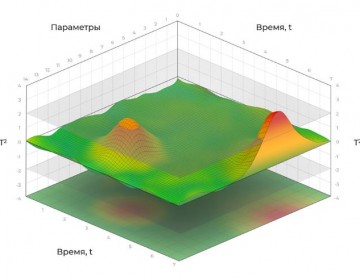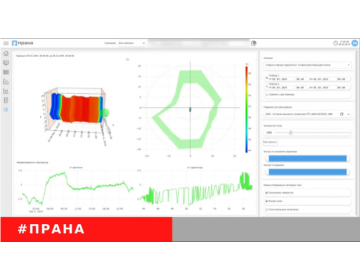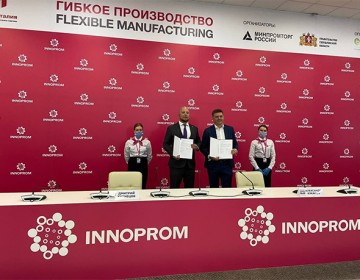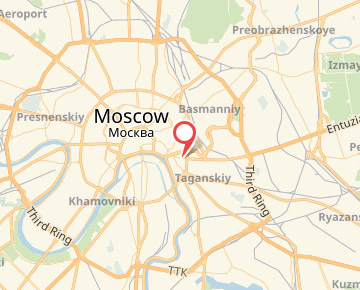The Present and the Future of Predictive Analytics Systems in Industrial Enterprises
Industrial predictive analytics technologies are becoming more popular. New approaches to data processing are already helping to increase safety, reduce operating costs and improve statistics of technical failures of enterprises in different industries. Igor Trudonoshin, Director of the PRANA System Software Development Department of ROTEC JSC, told ComNews how predictive analytics works, what the boundaries of its application and development potential are.
Predictive analytics systems are one of the most important elements in the fourth technological revolution. According to Allied Market Research, these technologies are most requested in such industries as semiconductor electronics, energetics, pharmaceuticals, automotive industry and heavy engineering. The market for such solutions will grow by 2026 at an average annual rate of more than 20%. And this shouldn’t be surprising.
Analysts from McKinsey have calculated that the introduction of predictive analytics (for predicting failures in industrial equipment) can reduce downtime by 30-50% and increase lifetime by 20-40%. Given the amount of savings in question, manufacturers simply cannot ignore this opportunity. But what is predictive analytics? What are its prospects and limits of applicability? Let’s figure it out.
Ever since humanity began to use technically sophisticated equipment, it has faced the issue of predicting their failures. An experienced specialist could determine the upcoming failure by ear, visually or in any other accessible way. This allowed repairs to be made before a failure or an accident occurred.
As technologies became more sophisticated, the number of equipment parameters to be monitored also increased. The control rooms of the first NPPs were literally stuffed with hundreds of analog instruments, the readings of which were used by experienced specialists to judge how the reactor behaves. However, there was no archive of information; at best, there were recorder tracings, unsuitable for machine analysis.
The computer revolution and the emergence of automated control systems have become a real breakthrough in the industry and have allowed the creation of much more sophisticated machine tools, turbines, motors and many other high-tech systems. It is worth mentioning that now a modern typical gas turbine power unit generates about 1,000-2,000 measurements of digital data from various sensors.
The reliability of the equipment is ensured by conducting a complex set of scheduled maintenance checks. Regardless of how much the device’s operating parameters have deviated over the past period of time, it is temporarily taken out of service for maintenance. These actions are preventive in nature, but strictly mandatory.
But even the strictest operating procedures cannot fully protect against failures and accidents when it comes to sophisticated equipment. Even two absolutely identical samples, rolled off the production line one after the other, will have slightly different performance characteristics, and one of them will fail earlier than the other one. But a modern foreman can no longer detect an upcoming failure by ear or visually, when it comes to even hundreds of controlled parameters, not to mention thousands.
Glancing into the Future
The basis for the most advanced traditional control systems is the determination of threshold values. They help to understand that the vibration of the bearing assembly has exceeded the permissible value, or the coolant temperature has gone beyond the design limits. The system operator receives notification, and response algorithms are triggered. But the event has already occurred and requires intervention right now.
Would it be extremely useful to know that the bearing will collapse in a month, and the valve in the coolant circulation system will jam in a week? This is where predictive analytics based on mathematical modeling methods can be useful.
Predictive analytics is based on the search for processes that take place in the streams of data from sensors. Even if there are thousands of such sensors, the software can analyze all of them. Using the tools of mathematical statistics, such software can predetermine how long it takes for a particular parameter to reach a threshold value. This means that a failure or an accident can be prevented. And it already works.
Practical Aspects
Let’s consider an example from our practice. At one of the oil fields, the engine of the pumping unit was damaged in the first stage of the compressor, which was not detected by the standard diagnostic system – the vibration threshold was not exceeded. At the same time, the analytical system located thousands of kilometers away noticed changes in the telemetric parameters and changed the index of the general technical condition of the unit, which attracted the operator’s attention.
The equipment was stopped and examined on a scheduled basis. It turned out that part of the turbine blade had broken off. Moreover, the performance characteristics remained within tolerances. This would later lead to a breakdown or complete destruction of the compressor and the need for costly repairs.
Or another example. The predictive analytics system detected a decrease in the efficiency of the engine lubrication system due to oil coking. It is impossible to track this parameter manually, and the control system in such a situation would react only when the temperature threshold value is exceeded. The remote operator, who monitors many such devices at once, received a notification, assessed the situation and gave the command to stop the engine. The device would be turned off automatically, but only after several hours of operation in oil starvation mode. Any engineer would tell you that this could be the reason for a major overhaul. In this case, however, planned preventive work was enough.
What Is beyond the Capability of Predictive Analytics
Predictive analytics is at an early stage of development, so the possibilities are still limited.
One of the main constraints is insufficient digitalization of industrial equipment. At the same time, its cost is such that there can be no thought of its early replacement. Accordingly, predictive analytics methods can only be applied to relatively new equipment with advanced digital telemetry capabilities. Sometimes, such devices can be retrofitted with sensors, but this method is expensive and also requires changes to the technical design, which is not always possible.
The second constraint is the need for expert control. No matter how perfect the predictive system is, it can only suggest to a live specialist to pay attention to certain atypical processes developing in the equipment. And the specialist himself, relying on his experience, can draw a conclusion about what factors could cause increasing deviations.
The third factor is at the junction of the first two. The problem of the mandatory presence of an expert in the decision-making chain could be partially solved through the introduction of machine learning. But neural network training requires huge data sets – telemetry archives for many years of operation of each type of equipment. They have not yet been accumulated. In addition, modern industrial equipment has become so reliable that even a large archive is not always enough to generate failure statistics used for neural network training.
Development Prospects
There are now two main ways to improve predictive analytics methods in production. The first is the gathering of data on operating parameters and statistics of breakdowns not on real equipment, but on its mathematical model – a “digital twin” containing complete information about all physical properties of the real object. By changing the state of this model, it is possible to simulate a variety of deviations in work, and later use the resulting scenarios in failure prediction systems.
The second direction of technology development requires the emergence of new types of neural networks, which, at least in some approximation, could take over the functions of the expert, thereby reducing the factor of human participation in data evaluation. We do not yet know how such AI elements will work, but in the long term they will certainly appear – many market participants are interested in this.
Why Should We Start Now?
Now, the introduction of predictive analytics technologies allows reduction in operating costs by decreasing the number of failures and optimizing the preventive maintenance schedule. The effectiveness of analytics increases even more if it relies on the accumulated telemetry archive. Actually, the possibility of obtaining valuable conclusions from an analysis of the past states of the controlled system is one of the key advantages of the new method. Thanks to AI elements already available in predictive analytics systems, the study of the history of equipment operation allows conclusions about how typical or atypical the current parameters are.
Even if no forecasting system is now able to show the result for a specific type of equipment, the set of statistically important information that comes from this object will be used later. In the future three to five years, a suitable method of analysis may appear that can be “trained” using the existing archive.
Moreover, we can now prepare for the next generation of predictive technologies. In particular, create a complete set of reference information on which the algorithms could rely. This set should include basic information about the structure of the object, the composition of its aggregates, their properties and characteristic operating parameters. Later, in combination with the accumulated archives of parameters, this array of information will become an excellent basis for implementing the methods of analysis that are still being developed.
Source: COMNEWS
The PRANA Predictive Analytics and Remote Monitoring System has received another update of the operating system.
The industrial holding ROTEC JSC and Group-IB, one of the leading developers of solutions for detecting and preventing cyberattacks have entered into a cooperation agreement to ensure technological and cybersecurity of critical infrastructure facilities. The agreement was signed at the International Industrial Trade Fair Innoprom 2021 and will allow ACS and IS specialists of enterprises to observe and take proactive measures to prevent incidents caused both by service wear of equipment and as a result of cyberattacks.
The industrial Internet begins with the introduction of systems based on mutual penetration of information technologies and automation devices of manufacturing equipment, such as the systems of remote monitoring and diagnostics. One of the inspection methods of the equipment’s condition is its continuous monitoring, which is a necessary condition for the transition to a service system on the operating condition
According to Mikhail Lifshitz, Chairman of the Board of Directors of ROTEC, Russian power engineering company, the venture capital market in its present state is currently raising people whose aim is not to create a winning product, but just to raise funds. With regard to his business, Mr. Lifshitz abandoned the speculative component and headed for the long-term integration of ideas into production.
Despite the hazy weather and pouring rain, the yachtsmen were in a terrific mood! Three crews of racing yachts in Olympic Class SB20, mainly represented by employees of ROTEC, PRANA and TEEMP, took the whole winners podium in the amateur competition. For most of the participants, it was their first-ever experience of this kind – and they claimed victory straight away!
The trend towards digitalization and flourishing of the service economy have led to the emergence of a new model – Maintenance-as-a-Service. Let’s explore how it’s organized and the benefits that it offers to business.
The Internet of Things (IoT) integrates devices into a computer network and allows them to collect, analyze, process and transmit data to other facilities via software, applications or technical devices















